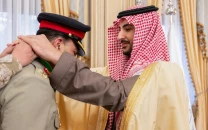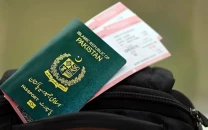Balancing acts through deceptive diplomacy
Since the day of their independence, Pakistan and India have pursued different foreign policy agendas

The art and practice of managing relations between countries through treaties, alliances and talks in order to advance shared interests and settle disputes amicably on a global scale is known as international diplomacy. It encompasses the strategies and tactics employed by states to navigate complex geopolitical landscapes and advance their foreign policy objectives.
Since the day of their independence, Pakistan and India have pursued different foreign policy agendas. Pakistan quickly became an ally of the United States, while India chose to remain non-aligned and lead the Non-Aligned Movement. This difference became even more apparent when Russia and India forged a strategic alliance that would last for a long time. The repercussions of these diplomatic manoeuvres were felt acutely, especially at critical junctures like the Soviet-Afghan War in the 1980s, when India sided decisively with Russia. But when the geopolitical landscape changed and the US started to surround China, India adjusted its strategic calculus and became closer to the US. The historic 2002 nuclear agreement known as the 123 Agreements for Peaceful Cooperation marked the conclusion of this strategic realignment. However, India has been accused of using different standards because of its efforts to keep friendly ties with both the United States and Russia. Recent circumstances, in which India linked with providing arms to Ukraine with rising tensions with Russia, serve as an example of this. This striking of balance between two love affairs has created complications for India forcing her to rather resort to a dubious interplay of relations with both countries.
Indian Foreign Minister Subrahmanyam Jaishankar conversations give the sense that India is still standing strongly behind Russia, as it has in the past, but it is also carefully navigating its relationship with the United States in order to forward its strategic objectives. It appears that these meetings might be a diplomatic façade, concealing a more nuanced approach to international relations aimed at playing a diplomatic gimmick with both the United States and Russia. When Mr Jaishankar met Russian authorities in late 2023, he emphasised the longstanding strategic connections between the two nations. In the midst of the crisis in Ukraine, Jaishankar tried to bring back summit talks and uphold India’s circumspect position, striking a balance between Russia and the West. Even though it was a low-key visit, Jaishankar, following his discussion with President Vladimir Putin, hinted at the possibility of an India-Russia summit in 2024. India’s position in the current issue is made more complicated by recent BBC revelations that expose the recruiting of Indian citizens to fight with the Russian military in the battle against Ukraine. In the meanwhile, the Modi government’s growing reliance on the US rather than its customary reliance on Russia for armaments acquisition represents a significant shift. While Russia and India have long collaborated on programmes such as the Su-30MKI fighter jet and BrahMos cruise missile, India’s strategic alliance with the United States is becoming more significant. In light of this, Russia has publicly expressed concerns to New Delhi over the purported transit of munitions manufactured in India to Ukraine via Europe during the third quarter of the preceding year. The Economic Times said that reports originating from both Russian and Ukrainian sources indicate that Ukraine could have been the recipient of Indian 155mm artillery munitions. Observers have detected the presence of ammunition and mortar rounds with Indian provenance on Ukrainian battlefields, raising doubts about India’s participation and involvement in the worsening crisis despite India’s declared neutrality in the conflict.
According to recent media reports, Germany is allegedly in talks with India about supplying and restocking ammunition and other military hardware, and it has apparently exhausted its war stocks meant for Ukraine. The Indian government’s prompt denial of these allegations, however, raises the possibility of a covert intent. Furthermore, serious concerns are raised by India’s possible mass export of these weapons. The geopolitical dynamics at play are further complicated by Russia’s recent reluctance to provide India weapons, which raises suspicions that India may be using its own weapons against Russia. The paradoxical nature of India is exposed by recent reports from the Indian government that shows a significant number of Indians are enlisting in Russia’s war against Ukraine and fighting with Russian soldiers on the front lines. Mohammed Asfan (30) and Hemal Ashwinbhai Mangukiya (23), two Indian citizens, have perished in this conflict, according to confirmation from the Indian Embassy in Moscow. International reputable media’s possession of complete transcripts of interviews of Indians fighting against Ukraine further reinforces India’s dubious diplomatic overtures.
The Bharatiya Janata Party’s boasts of a ‘Shining India’ and economic advancement are called into doubt by these findings, which also expose systematic corruption and bureaucratic incompetence. India’s circumspect stance on standing with superpowers such as the US and Russia highlights the challenges associated with managing geopolitical alliances. India is an unstable partner because it is hesitant to completely commit to either the US or Russia, even if it sees the US pivot to Asia as a chance to push its interests in the South China Sea. These challenges highlight the necessity of changes in order to protect Indian citizens and reaffirm India’s place in the international community.
Published in The Express Tribune, April 28th, 2024.
Like Opinion & Editorial on Facebook, follow @ETOpEd on Twitter to receive all updates on all our daily pieces.


1729685382-0/Untitled-design-(57)1729685382-0-208x130.webp)












COMMENTS
Comments are moderated and generally will be posted if they are on-topic and not abusive.
For more information, please see our Comments FAQ